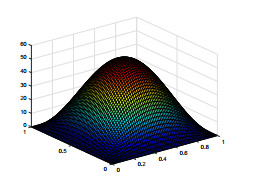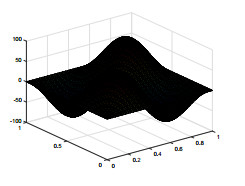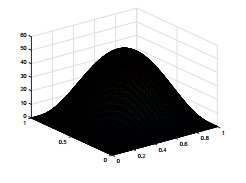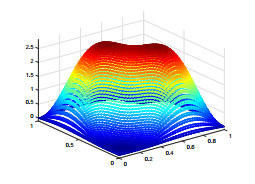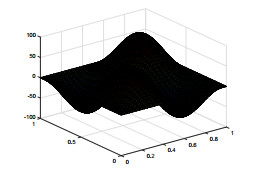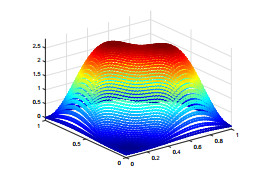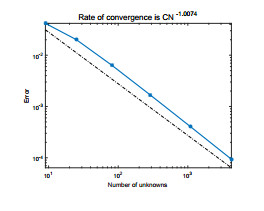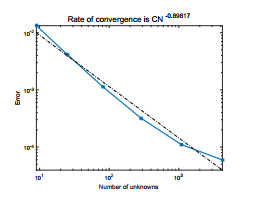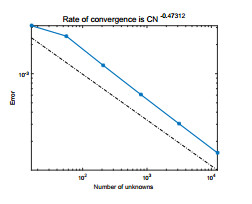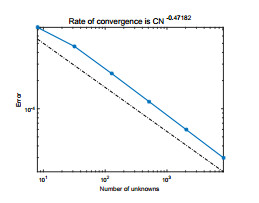1.
Introduction
In this study, we consider the following mathematical model of a semiconductor device, which consists of three quasilinear partial differential equations [1,15]:
where (1) is an elliptic-type partial differential equation for the electric potential, and (2) and (3) are parabolic-type partial differential equations for the electron and hole concentrations. The unknown functions are the electrostatic potential ψ, the electron concentration e, and the hole concentration p. Ω is a polygonal domain in Rd(d=2,3). The value of α is q/ϵ, q is the electron charge, and ϵ is the dielectric permittivity. These are all positive constants. N(x)=ND(x)−NA(x) is a given function of ND(x) and NA(x) that represents the donor and acceptor impurity concentrations. The diffusion coefficients Ds(x)(s=e,p) and the mobilities μs(x)(s=e,p) obey the Einstein relation Ds(x)=UTμs(x), where UT is the thermal voltage. R(e,p) is a recombination term.
It is assumed that the boundary and initial conditions are as follows:
In addition, we need the compatibility condition
The study of the transient behaviors of semiconductor devices plays an important role in modern computational mathematics. Since Gummel [14] first presented sequence iterative computation methods for this kind of problem in 1964, a variety of numerical approaches have been introduced to obtain better approximations for (1)–(3). The main techniques include the difference method [13], finite element method [27], mixed finite element method [25], characteristics finite element method [26], characteristics finite difference method [24], upwind finite volume method [21], and characteristics mixed finite element method [22].
The semiconductor device problem becomes a large system of non-linear equations when using the finite element method to solve (1)–(5). Thus, we will consider a highly efficient and accurate algorithm for this large system. It is well known that the two-grid algorithm is a simple but effective algorithm. This method was first proposed by Xu for non-linear elliptic equations [18,19] and has been widely used in many kinds of problems. Dawson [10] applied a two-grid finite difference scheme for non-linear parabolic equations. Chen [6,5] presented an efficient two-grid scheme for semi-linear reaction–diffusion equations and miscible displacement problems. Dai [9] used a two-grid method based on Newton iteration for the Navier–Stokes equations. Chen and Yang [4] introduced this method for finite volume element approximations of nonlinear parabolic equations. Yu [23] presented a two-grid algorithm for mixed Stokes–Darcy problem. Wang investigated this method for semilinear elliptic interface problem [16]. Xu and Hou recently used this method for semilinear parabolic integro–differential equations [20]. Thus, it would be natural to use the two-grid method for the equations of a semiconductor device.
The electric field intensity u=−∇ψ is very important in production, and the numerical behavior of (2) and (3) strongly depends on the accuracy of the approximation of u. To improve the accuracy of e and p, we apply the mixed finite element method, which gives direct approximations of ψ and u simultaneously for the electric potential equation (1). The direct approximation of the electric field intensity, rather than one that requires differentiation of ψ, can provide improved accuracy for the same computational effort.
We use the characteristics finite element method for the electron and hole concentration equations, (2) and (3), respectively. In reality, the values of Ds(s=e,p) are quite small in the concentration equations, and thus, (2) and (3) are strongly convection dominated. The standard finite element method produces unacceptable numerical diffusion or nonphysical oscillations in the concentration approximation. The characteristics finite element method was introduced and analyzed by Douglas and Russell [12] in 1982. Using this method to treat the hyperbolic parts of the concentration equation, the procedure is simple, the time-truncation errors are smaller, and lastly and most importantly, nonphysical oscillations are avoided.
We determine the Lq error estimates for the mixed finite element solutions and the characteristics finite element solutions. We then present an efficient two-grid method based on the idea of Newton iteration. To the best of our knowledge, few results about the application of the two-grid algorithm to semiconductor device problems have been reported. The main idea of this algorithm is to solve the nonlinear coupled equations on a coarse grid, and then to solve the linear equations on a fine grid rather than solving the coupled nonlinear equations on the fine grid. Finally, we obtain the Lq error estimates for this algorithm and give the numerical experiment to illustrate the theoretical results. The two-grid algorithm achieves asymptotically optimal approximations but requires less time.
An outline of this paper is as follows. In Section 2, we present the weak formulation and full discrete scheme of this model. In Section 3, we present the Lq error estimates of the finite element solutions. In Section 4, we introduce a two-grid algorithm and analyze its convergence. Finally, the numerical experiment is presented in Section 5.
2.
Weak formulation and full discrete scheme
2.1. Notation and assumptions
In this paper, we denote Lq(Ω)={f:‖f‖Lq(Ω)<∞}, where
(L2(Ω))2 is the space of vectors that contains each component in L2(Ω). We define the Sobolev spaces as Wm,q(Ω)={f∈L1loc(Ω):‖f‖Wm,q(Ω)<∞}, whose norms are
To simplify the notation, we write Hm(Ω)=Wm,2(Ω), ‖⋅‖m=‖⋅‖m,2 and ‖⋅‖=‖⋅‖0,2. Let X be any of the spaces just defined. If f(x,t) represents functions on Ω×J, we set
For convenience, we drop Ω from the notations. Thus, we write L∞(J;Hk+3) for L∞(J;Hk+3(Ω)).
We let (⋅,⋅) be the L2(Ω) inner product. Furthermore, H10(Ω)={f∈H1(Ω):f|∂Ω=0}, and H(div;Ω) is the set of vector functions in (L2(Ω))2 that have ∇⋅v∈L2(Ω). We also define
We provide some rational assumptions about the coefficients and the solutions of (1)–(3). These assumptions are reasonable in physics [15,14].
(1) For integers l,k≥0, the solution functions have the following regularity (A)
(2) The problem is positive definite, such that
where D∗, D∗, μ∗, and μ∗ are positive constants.
(3) |∇μs(x)|≤C,s=e,p.
(4) R(e,p) is Lipschitz continuous in an ε-neighborhood of the solutions.
2.2. Characteristics method for the concentration equations
For the electron and hole concentration equations, (2) and (3), respectively, convection is dominant over diffusion, so we use the characteristics finite element method to solve them.
We rewrite (2) and (3) in the form
where u=−∇ψ.
We let u=(u1,u2)T, τe be the unit vector in the direction (−μeu1,−μeu2,1), τp be the unit vector in the direction (μpu1,μpu2,1), and ϕs=√1+μ2s(u21+u22) (s=e,p). The characteristic derivatives in the t direction are given by
Associated with the equations above, (7) and (8) can be rewritten as follows:
We partition J into △t=T/N and tn=n△t. Furthermore, we denote fn(x) as f(x,tn) and (∂en/∂τe)(x) as (∂e/∂τe)(x,tn). The backward difference quotient in the τe-direction is as follows:
Defining ˆxn−1e=x+μeun(x)△t and ˆen−1(x)=en−1(ˆxn−1e), then
Similarly,
Defining ˆxn−1p=x−μpun(x)△t and ˆpn−1(x)=pn−1(ˆxn−1p), then
2.3. Weak form and full discrete procedure
The weak forms of (1), (9) and (10) are equivalent to the following problem: for t∈J, find a map {ψ,u,e,p}:J→W×V×H10(Ω)×H10(Ω) such that e(x,0)=e0(x), p(x,0)=p0(x):
We let Thψ and Thc be a quasi-uniform mesh of Ω comprising triangles or rectangles such that the elements have diameters bounded by hψ and hc. We denote Wh×Vh⊂W×V as the Raviart–Thomas mixed finite element spaces with order k. The approximation properties are given as follows:
We denote Mh⊂H10(Ω) as a piecewise polynomial space of degree l, and
Using (11) and (12), the full discrete scheme of the weak form, (13)–(16), consists of {ψnh,unh,enh,pnh}∈Wh×Vh×Mh×Mh, given by
where ∂τeenh=enh−ˆen−1h△t and ∂τppnh=pnh−ˆpn−1h△t. In addition, the initial approximations e0h and p0h must be determined by the elliptic projections of e0 and p0.
3.
Lq error estimate of finite element solution
In this section, we present the Lq error estimate of the mixed finite element method for the electrostatic potential and electric field intensity and the characteristics finite element method for the concentrations.
3.1. Convergence analysis of mixed finite element solution
First, it is useful to introduce an elliptic mixed method projection (Rhψ,Rhu):J→Wh×Vh, which satisfies
Following Brezzi [3], we have
The estimations of ψnh−Rhψn and unh−Rhun are derived as follows. By subtracting (21) and (22) from (17) and (18), respectively, at time t=tn, we determine that
Following Brezzi [3], we have
3.2. Lq error estimate of characteristics finite element method
We introduce an elliptic method projection (Rhe,Rhp):J→Mh×Mh such that
where the positive constants λs(s=e,p) will be chosen to ensure the coercivity of the forms. Based on the theory of the Galerkin method for elliptic problems [8,17], we have
To obtain the convergence estimations of ‖sn−snh‖0,q(s=e,p), we divide them as follows:
For the concentration, we only discuss the electron concentration equation, as the results were similar for the hole concentration equation. First, we obtain the convergence results of ‖sn−Rhsn‖0,q(s=e,p) with help of an elliptic problem.
Lemma 3.1. If (en,pn) is the solution of (15)–(16) at t=tn, and (Rhen,Rhpn) is the elliptic projection solution of (27)–(28) at t=tn, then for 1≤n≤N, 2≤q<∞ and l≥1, we have the following:
Proof. We let L denote an elliptic operator such that
and it has a bilinear form
where λ will be chosen to ensure the coercivity of a(en,z). From (27), it is clear that Rhen is the finite element solution of this elliptic problem. We consider the auxiliary problem
This problem is uniquely solvable for ω∈Lp(Ω), and
where 1p+1q=1. We use a duality argument. Based on (27), Hölder's inequality, and (33), we denote Ih as an interpolation operator and obtain
From [2,Theorem 8.5.3] and the approximation property, we have
Using (34) and (35), we have
Lastly, we obtain similar results for the hole concentration equation.
Next, we obtain the convergence property for ‖Rhsn−snh‖0,q(s=e,p).
Lemma 3.2. Let (Rhen,Rhpn) be the elliptic projection solution of (27)–(28) at t=tn, and (enh,pnh) be the finite element solution of (19)–(20). If the regularity assumptions (A) hold, and the initial functions e0h=Rhe0 and p0h=Rhp0, then for 1≤n≤N, 2≤q<∞ and l,k≥1, we have
Proof. The proof process is similar to the analysis presented by [25] and [26], but with some changes. First, we subtract (15) and (27) from (19) at t=tn to have
We let ξne=en−Rhen, ζne=enh−Rhen, ξnp=pn−Rhpn, ζnp=pnh−Rhpn, and select z=ζne−ζn−1e=∂tζneΔt. Summing over 1≤n≤m, from (38), we have the following:
where
Now we estimate each term on the right hand of (39). First, using a second-order Taylor expansion at point (enh,pnh) for R(en,pn), Young's inequality, and (29), we have
where Re and Rp are the partial derivatives for each variable.
For F2, we have
For the estimation of F3, using (29), we get
As to F4, we obtain similar estimate:
For F5, we obtain
where the calculations of (41), (42), and (44) are presented in detail elsewhere [25,26].
For F6, from (29) we have
Next, we obtain an error estimate for F7. Using (26), (29), and (23), we have
Hence, we conclude that
Finally, for F8, we have
From (29), we can determine the following:
Thus, we have
Combining (39) with (40)–(47) and noting that e0h=Rhe0 and p0h=Rhp0, we have
To obtain the H1 norm of ∇ζme, we add ‖ζme‖2 to the above equation. Note that
The both sides of the above inequality are sum from n=1 to m, then we have
Similarly, for the L2 estimates of ∇ζp and ζp, we find that
Combining (48)–(51) and selecting sufficiently small values of Δt and ε, we obtain
where C=C(ε) is a constant that depends on ε. An application of the discrete Gronwall Lemma yields the following:
Then, for 1≤m≤N, we determine that
Similar to the proof process of Theorem 3.4 in [19], we determine that
We apply a duality argument to estimate ‖enh−Rhen‖0,q by considering an auxiliary problem: find ω∈H10(Ω) such that
This problem is uniquely solvable for ω∈Lq(Ω), and
where p=q/(q−1)∈[1,2] for 2≤q≤∞. If s=2q/(q+2), applying the Sobolev embedding theorem, we have
By Lemma 3.1 of [19] and (53), we have
For q=2, since s=1, from (52), we have the following:
For 2<q<∞, since 2s<q, we have
which yields (36). Similarly, we can obtain (37).
From Lemmas 3.1 and 3.2, we obtain the following important theorem:
Theorem 3.3. Let (en,pn) be the solution of (15)–(16) at tn, and (enh,pnh) be the finite element solution of (19)–(20). If the regularity assumptions (A) hold, and the initial functions e0h=Rhe0 and p0h=Rhp0, then for 1≤n≤N, 2≤q<∞ and l,k≥1, we have
3.3. Lq error estimate of mixed finite method
First, it is useful to denote the L2 projection Qh as follows. For ρ∈(L2(Ω))2,
For ρ∈(Wk+1,q(Ω))2, the L2 projection operator has approximation property [11]:
Next, the Lq error estimate of the electrostatic potential will be obtained. We obtain the following error equations by subtracting (13) and (14) from (21) and (22), respectively:
Let Dh be the L2-projection onto the space
Dh has the following stability property [7]:
Lemma 3.4. If un and Rhun are the solutions of (13)–(14) and (21)–(22), respectively, at t=tn. For 1≤n≤N, 2≤q<∞ and k≥1, we have
Proof. This Lemma can be easily derived from (58) and (60). More details of the proof can be found in [6,Lemma 3.2] and [5,Lemma 4.1].
For (25), if 1/p+1/q=1, we have
Lastly, we obtain the Lq error estimate of the electric field intensity:
4.
Two-grid algorithm and error estimate
The two-grid algorithm and its convergence analysis are presented in this section. The fundamental ingredient of the scheme is a new finite element space VH×WH×MH×MH⊂Vh×Wh×Mh×Mh(h<H<1) defined on a coarser quasi-uniform triangulation or rectangulation of Ω. The non-linear equations can be solved by applying the Newton iteration procedure on the fine grid to linearize the non-linear system. The solutions of the original non-linear system will be reduced to the solutions of a small-scale non-linear system on the coarse space and a linear system on the fine space. First, we provide the two-grid algorithm.
Step 1. Solve the non-linear coupled system for (unH,ψnH,enH,pnH)∈VH×WH×MH×MH on the coarse grid TH:
Step 2. Solve the linear coupled system for (Unh,Ψnh,Enh,Pnh)∈Vh×Wh×Mh×Mh on the fine grid Th:
where R(Enh,Pnh)=R(enH,pnH)+Re(enH,pnH)(Enh−enH)+Rp(enH,pnH)(Pnh−pnH).
Next, we present an error estimation analysis of the exact solutions (un,ψn,en,pn) and two-grid solutions (Unh,Ψnh,Enh,Pnh). We note that (Unh,Ψnh) are the two-grid solutions defined in (69) and (70). Using (23), (26), and triangle inequality, we can analyze the electrostatic potential and electric field intensity:
Next, we prove ‖en−Enh‖0,q and ‖pn−Pnh‖0,q. The elliptic projection will be used as an intermediate variable to assist this proof, and the main results are as follows:
Lemma 4.1. Let (Rhen,Rhpn) be the elliptic projection solution of (27)–(28) at t=tn, (Enh,Pnh) be the two-grid solution of (71)–(72). If we choose E0h=Rhe0 and P0h=Rhp0, the regularity assumptions (A) hold, then for 1≤n≤N, 2≤q<∞ and l,k≥1, we have
Proof. We subtract (15) and (27) from (71) at t=tn to obtain the following error equation:
We let ηne=Enh−Rhen and ηnp=Pnh−Rhpn and select z=ηne−ηn−1e=∂tηneΔt. Summing over 1≤n≤m, from (76), we have
where
Now we estimate each term on the right hand of (77) as follows. First, using a second-order Taylor expansion at point (enH,pnH) for R(en,pn), (29), (54) and (55), we have
where e∗ is a point between en and enH, p∗ is a point between pn and pnH.
Similar to the proof process of Lemma 3.2, we give the following error estimations directly,
For K7, we have
Using (73) and (29), we have
Using (64), (54), and (31), we have
From (84)–(86), we obtain
For K8, we have
Related to J1, we have
Related to J2, we have
Using (54), (55), and (31), we have
Similar to J21, we have the same estimation of J22. Finally, for J3 we have
From (88)–(90), we obtain
Combining (77) with estimates (78)–(83), (87) and (91), and noting that E0h=Rhe0 and P0h=Rhp0, we have
Similar to the proof process of Lemma 3.2, we determine that
which yields (74). Similarly, we can obtain (75).
Using the triangle inequality, (31), (32), and Lemma 4.1, we have the following results:
Theorem 4.2. Let (en,pn) be the solution of (15)–(16) at t=tn, and (Enh,Pnh) be the two-grid solution of (71)–(72). If the regularity assumptions (A) hold, and the initial functions E0h=Rhe0 and P0h=Rhp0, then for 1≤n≤N, 2≤q<∞ and l,k≥1, we have
Lastly, from Theorem 4.2 and (73), we obtain
Theorem 4.3. Let (ψn,un) be the solution of (13)–(14) at t=tn, and (Ψnh,Unh) be the two-grid solution of (69)–(70). If the regularity assumptions (A) hold, and the initial functions E0h=Rhe0 and P0h=Rhp0, then for 1≤n≤N and l,k≥1, we have
5.
Numerical experiment
In this section, the numerical experiment is presented to illustrate the efficiency of the two-grid method for solving the semiconductor device problem in Section 4.
We consider the following equations with Dirichlet boundary condition:
where Ω=(0,1)2, t∈[0,T]. We take the exact solutions of (97)–(99) are
The right hand sides f1 and f2 are determined by the above exact solutions.
We use piecewise constant for ψ, the lowest Raviart–Thomas element for u and piecewise linear continuous function for e, p. We select the time step τ=1.0e−2 and T=1. For the sake of simplicity, we assume hψ=hc=h, Hψ=Hc=H. The exact solutions en, pn, ψn, the characteristics finite element and the mixed finite element method solutions enh, pnh, ψnh and the two-grid method solutions Enh, Pnh, Ψnh are shown in Figs. 1-9. To compare these pictures, we can see that the solutions of finite element method and two-grid method are identical with the exact solutions. From Figs. 10-13, we can observe that the convergence rate of the error for ‖en−enh‖, ‖pn−pnh‖, ‖ψn−ψnh‖, and ‖un−unh‖, respectively. In Tables 1–3, we present the numerical results for error estimates and CPU time cost of the finite element method and the two-grid method. As shown in Tables 1–3, we can know that when the coarse grid and the fine grid satisfy H=h12, the two-grid method achieves the same accuracy as the finite element method but requires less time.
6.
Conclusion
This paper has presented a two-grid algorithm for coupled semiconductor device equations discretized by the mixed finite element method and the characteristics finite element method. The fundamental idea of the two-grid method is that we can solve non-linear equations by applying the Newton iteration procedure on the fine grid to linearize the non-linear system. It was shown that the two-grid method still achieves asymptotically optimal approximations as long as a mesh size between those of coarse and fine grids satisfies H=O(h1/2). From the numerical experiment, we can find that less time will be required for the two-grid algorithm since only a small-scale non-linear problem must be solved. Hence, the two-grid method is an effective method for solving the semiconductor device problem. In our future work, we will consider more complicated two-grid algorithms for the semiconductor device problem by the mixed finite element method of characteristics.
Acknowledgments
We would like to express our gratitude to the anonymous referees for their helpful suggestions.
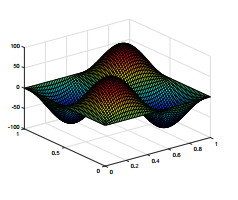









 DownLoad:
DownLoad:
